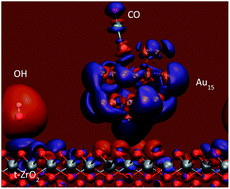Structure–activity relationship of Au/ZrO2catalyst on formation of hydroxyl groups and its influence on CO oxidation†
Abstract
The effect of changes in morphology and surface hydroxyl species upon thermal treatment of

* Corresponding authors
a
Edgewood Chemical Biological Center, 5183 Blackhawk Rd., APG, Maryland 21010-5424, USA
E-mail:
christopher.j.karwacki.civ@mail.mil
Fax: +1 (410) 436-5513
Tel: +1 (410) 436-5704
b Center for Nanophase Materials Sciences, Oak Ridge National Laboratory, Oak Ridge, TN 37831, USA
c Computer Science and Mathematics Division, Oak Ridge National Laboratory, Oak Ridge, TN 37831, USA
d Department of Materials Science and Engineering, A. J. Drexel Nanotechnology Institute, Drexel University, 3141 Chestnut Street, Philadelphia, PA 19104, USA
The effect of changes in morphology and surface hydroxyl species upon thermal treatment of

 Please wait while we load your content...
Something went wrong. Try again?
Please wait while we load your content...
Something went wrong. Try again?
C. J. Karwacki, P. Ganesh, P. R. C. Kent, W. O. Gordon, G. W. Peterson, J. J. Niu and Y. Gogotsi, J. Mater. Chem. A, 2013, 1, 6051 DOI: 10.1039/C3TA00081H
To request permission to reproduce material from this article, please go to the Copyright Clearance Center request page.
If you are an author contributing to an RSC publication, you do not need to request permission provided correct acknowledgement is given.
If you are the author of this article, you do not need to request permission to reproduce figures and diagrams provided correct acknowledgement is given. If you want to reproduce the whole article in a third-party publication (excluding your thesis/dissertation for which permission is not required) please go to the Copyright Clearance Center request page.
Read more about how to correctly acknowledge RSC content.
 Fetching data from CrossRef.
Fetching data from CrossRef.
This may take some time to load.
Loading related content
